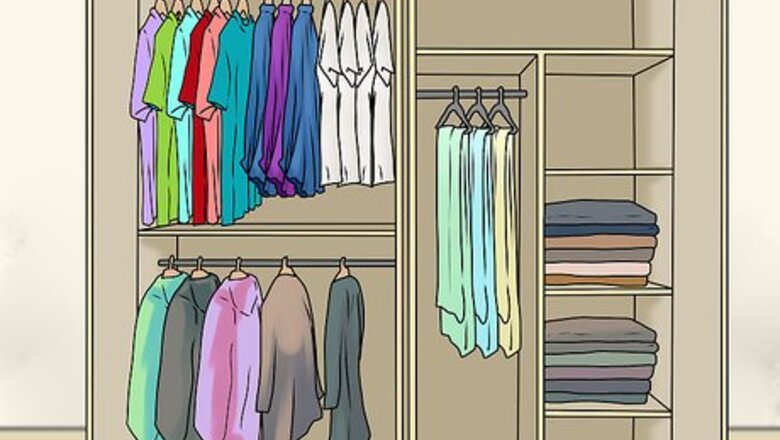
views
Making Your Wardrobe Look Neat
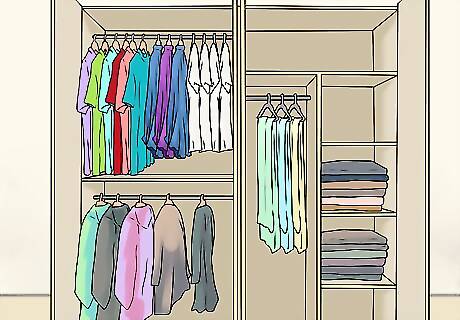
Organize your clothing by type. Instead of haphazardly hanging your clothing wherever you can, organize your closet into sections. Hang a certain type of clothing in each section. You will be able to locate the clothing you need much more quickly and your closet will look much neater. Sections can include: Shirts Skirts Pants Jackets Work clothing Special clothing, such as formal wear, suits, or costumes Pajamas
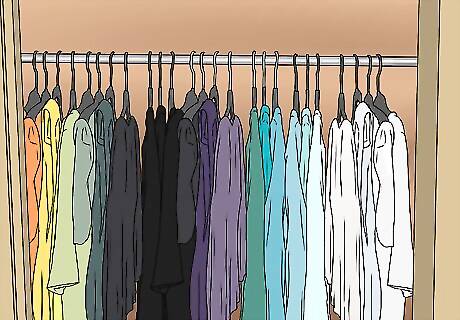
Organize each section in your closet. Now that your clothing has been separated into neat categories, rearrange the items in each one so that they look tidy. There are several ways you can organize the sections in your closet. For example: Within each section, organize the clothing by color, placing the lightest colors in the front and the darkest colors in the back. Arrange shirts by sleeve length. Separate your dresses by their length, placing the shortest in the front and the longest in the back.
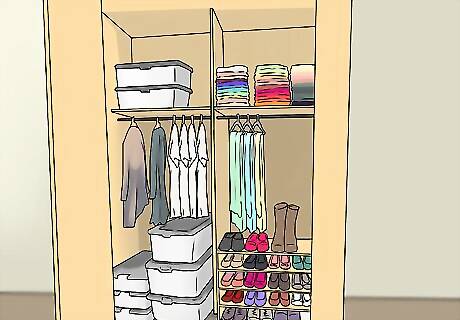
Use the vertical space in your wardrobe. If you have limited wardrobe space, use the areas above and below the clothing rack to store folded items, shoes, jewelry, and lingerie. If necessary, use organizational tools such as dividers or small boxes to help you organize the vertical space. For example: Store large purses on a shelf above the clothing rack. Stack two metal shoe racks under the clothing rack to store twice the number of shoes. Stack shoe boxes on a shelf above the clothing rack.
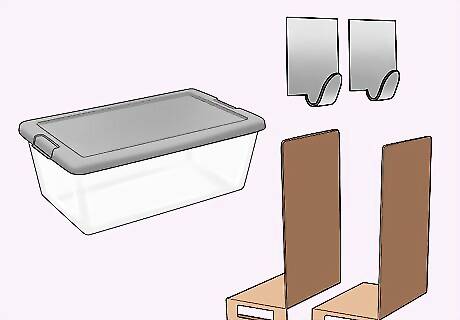
Consider purchasing organizational tools. There are many department stores and online shops that sell containers, hooks, racks, and dividers. These items can be used to attractively display your clothing and accessories while making them easy to access. For example: Use small, clear containers to store and stack shoes. Since you can see through the containers, you won’t forget about the shoes you store. Use shelf dividers above your clothing rack. These dividers can separate folded scarves, purses, or small handbags. Purchase small adhesive hooks and attach them to your closet wall or door. Use these hooks to store scarves, belts, or jewelry. EXPERT TIP Joanne Gruber Joanne Gruber Professional Stylist Joanne Gruber is a Professional Stylist based in Los Angeles, California. She has worked in the fashion and style industries for over 10 years, specializing in educating people on the art of re-purposing existing clothing to freshen up a wardrobe. Joanne opened The Closet Stylist in 2007, a personal style service combining wardrobe editing with organization. Joanne Gruber Joanne Gruber Professional Stylist Focus on making the most out of the space you have. Stylist Joanne Gruber says: "Velvet slimline hangers are a great way to save a lot of space in your closet. I also like L-shaped metal hangers for pants, because you can just slip the pants out of your closet. Adding extra bars in your closet will also help keep you maximize your space."
Storing Your Clothing

Hang any tops or blouses. If you fold these items, you can wrinkle or crease the clothing. Additionally, if it’s out of sight, you may forget you own it and you won’t wear it as often. Instead, hang your shirts and blouses in your closet on sturdy plastic or felt hangers. Pajama tops, old tee shirts, and other “around the house” tops can be folded and stored near lingerie.

Hang up lightweight dresses. Any lightweight and sturdy dresses you own can be hung up and organized by color, length, or style. This will keep your dresses wrinkle-free and easy to find. However, heavy dresses should be neatly folded and stored to avoid stretching out the shoulders. For example: Maxi dresses usually have thin, easily stretched straps. These dresses should be folded. Long dresses made of cotton-spandex blends can easily lose their shape if they’re hung up.
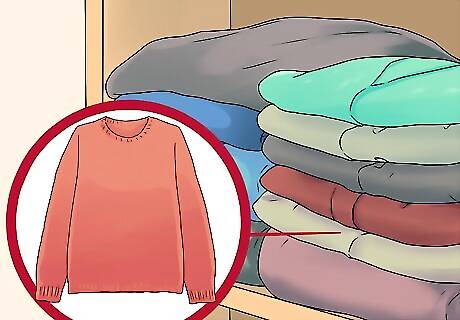
Fold and stack heavy sweaters. If you hang heavy sweaters up in your closet, the weight of the sweater will stretch out the shoulders. Instead, neatly fold your sweaters and store them in your wardrobe. For example: Stack the sweaters on the shelf above your clothing rack for easy access. Keep folded sweaters in plastic storage bins so that you can easily find them. Fill spare drawer space with folded sweaters. Store the stack of sweaters on its side so that each sweater is visible when you open the drawer.
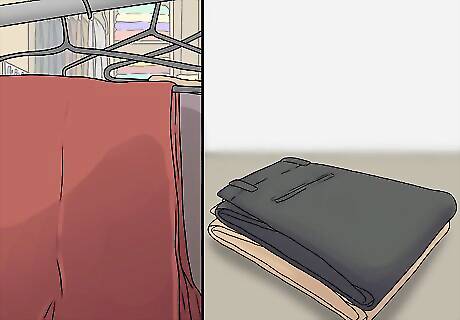
Hang or fold jeans. Jeans are made of sturdy material that doesn’t easily wrinkle. If you have a lot of wardrobe space, consider hanging the jeans up so that you can easily see each pair. Alternatively, store folded jeans in a drawer or clear bin to save wardrobe space. If you store folded jeans in a drawer, lay the stack of jeans on its side so you can easily see each pair. Hang jeans by folding them in half and draping them over the flat part of a hanger. Clip hangers can also be used to hang jeans by the waistband.
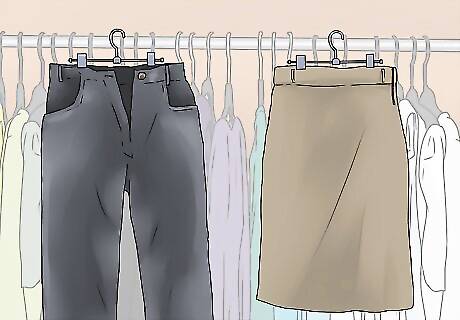
Hang up easily wrinkled bottoms. Nice trousers, work pants, flowing skirts, and pressed shirts should be hung up to avoid wrinkling them. To do so, use a clip hanger attached to the thick part of the waist band. If you don’t have room in your wardrobe to hang these items, consider installing or hanging another closet bar further down the wardrobe. Any casual shorts or pants can be folded and stored with your jeans.
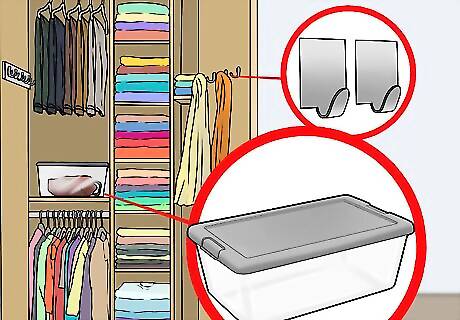
Use dividers and hooks to store accessories. If your wardrobe has a lot of empty wall space, consider purchasing small adhesive wall hooks. Use these hooks to attractively store jewelry, scarves, hats, purses, and belts. If you don’t have wall space, store these accessories in drawers. Use drawer dividers to separate each item. Avoid storing multiple necklaces on the same hook. If you do, they may become tangled. Roll up scarves before placing them in a section of a divider.
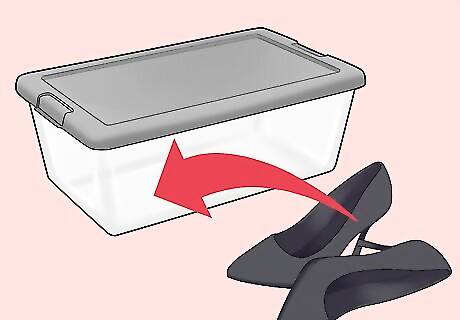
Organize your shoes. Shoes should be stored in clear containers, in shoe boxes, or on shoe racks. Resist the urge to store all of your shoes in one box or bucket. If you do, the shoes will become misshapen and scuffed. If you store your shoes in shoe boxes, tape a picture of the shoe on the front for quick identification. Metal shoe racks can be placed on the floor of your wardrobe. Cloth shoe racks can be hung on your wardrobe door or on the clothing rack.

Store small clothing in drawers. Any lingerie, socks, or bras can be stored in a drawer. Items can be separated in the same drawer using dividers. Bras can be stacked inside one another and laid in a line for easy storage, while underwear and socks can be rolled up. Make sure to circulate your bras so that you’re not wearing the same two or three all the time.
Reducing Your Wardrobe

Lay out your clothing. Pull all of your clothes from your wardrobe and lay them out on your bed. Organize the clothing by type and place them into piles. This will allow you to easily sort through your clothing while you decide what to keep and what to throw away. Wash and dry any dirty clothing. If half of your wardrobe is dirty, you won’t be able to properly sort through your wardrobe.
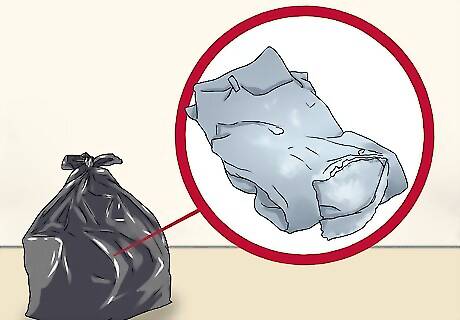
Throw away damaged clothing. If a piece of clothing has large stains or irreparable tears, throw it away. Be realistic about what you can and can’t fix. Small tears in seams can be easily repaired, but larger holes are harder to mend. If the job is too advanced for your sewing skills, consider throwing the clothing away. Don’t donate torn or stained clothing. The volunteers who receive the donation will have to trash them anyway. If expensive clothing is damaged, see a tailor. However, less expensive damaged clothing may not be worth the cost of the repairs.
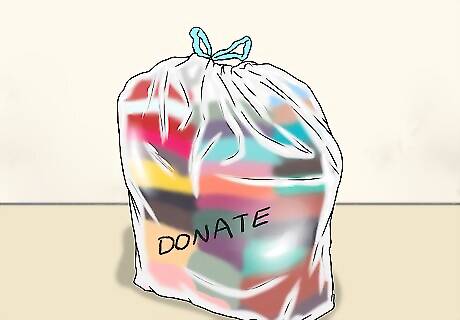
Choose clothing to donate. Sort through your undamaged clothing to find items to donate. Be harsh with yourself and remember that you’re trying to reduce the amount of clothing that you wear. Place donated clothing in large clean plastic bags and take them to your local clothing donation center. While sorting, ask yourself: ”If I was shopping right now, would I buy this?” ”Have I worn this in the past two years?” ”Is this piece of clothing too small or two big?” ”Do I feel good when I wear this?” When hanging items up, hang them in reverse of how you put them away. Then every time you wear something, hang it up normally. At the end of a year or season, clothes still hanging backwards should be considered for donation.
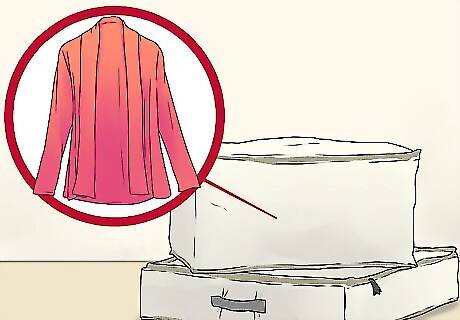
Store clothing. Any seasonal or sentimental items can be stored away until they’re needed. This will help clear up wardrobe space for other items or organizational tools. Bins of packed clothing can be stored under your bed, in a storage closet, or above your wardrobe. Delicate items such as silk or cashmere should be wrapped in tissue paper and stored in canvas storage bags. Regular clothing can be folded and stacked in large plastic bins. Only store clean clothes.













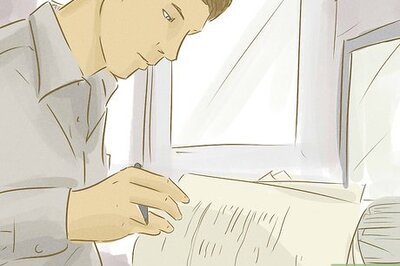





Comments
0 comment